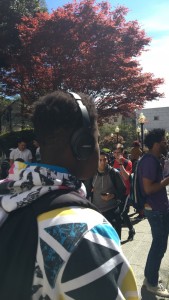Our color walk was quickly catalyzed by dark red-brown steps going down from Professor Arrington’s classroom. The exit signs illuminated above head directed us past the administrative offices and to the “Read Signal” letters box that sent us veering to the right only to lead us to another reddish brown path way broken up by the slope of stairs. Off to the left the bright red of two Coca-Cola machines lead us out to the quad where a myriad of red shades stop us, causing us to turn our heads in every direction to take it all in. Red shoes, the red leaves of several of the trees, when finally a boysitting at the fountain with bright- almost luminescent in the sunlight- red adidas pants pulls us to the square separating Langdale Hall, Kell Hall and Classroom South. In this square red hair, red socks tucked under the bright blue jeans of a student speed walking, a faded red shirt of someone sitting in the quad renders us motionless, again, as we work to take in and dutifully observe the many spectral shades of red around us. By the time our color walk was over at around 1:50 P.M., I noticed I had only observed a minuscule fraction of the colors all around us. While red was the first thing to catch my eye, my overall attention span was broadened to include the spectrum of all colors perceivable to my eye. This exercise is potentially useful to a researcher of any kind to use if done properly, for it awakens the sensitivity to acute detail in the mind. This can be translated into other forms of research by exercising the brain to be more attentive to all acute details- not just in color.

